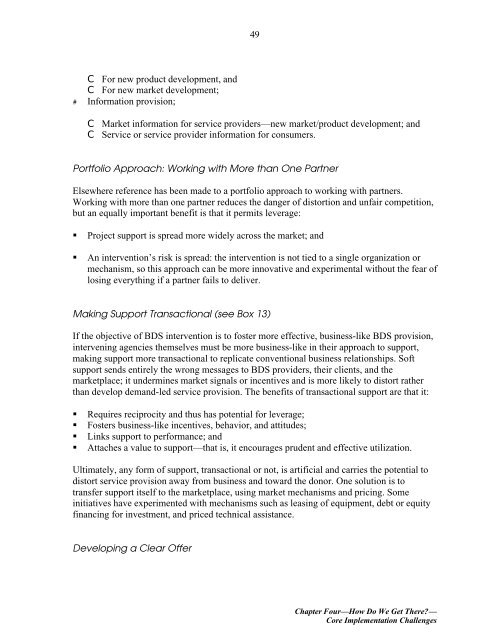BDS market development guide.pdf - PACA
BDS market development guide.pdf - PACA
BDS market development guide.pdf - PACA
You also want an ePaper? Increase the reach of your titles
YUMPU automatically turns print PDFs into web optimized ePapers that Google loves.
49<br />
C For new product <strong>development</strong>, and<br />
C For new <strong>market</strong> <strong>development</strong>;<br />
# Information provision;<br />
C Market information for service providers—new <strong>market</strong>/product <strong>development</strong>; and<br />
C Service or service provider information for consumers.<br />
Portfolio Approach: Working with More than One Partner<br />
Elsewhere reference has been made to a portfolio approach to working with partners.<br />
Working with more than one partner reduces the danger of distortion and unfair competition,<br />
but an equally important benefit is that it permits leverage:<br />
• Project support is spread more widely across the <strong>market</strong>; and<br />
• An intervention’s risk is spread: the intervention is not tied to a single organization or<br />
mechanism, so this approach can be more innovative and experimental without the fear of<br />
losing everything if a partner fails to deliver.<br />
Making Support Transactional (see Box 13)<br />
If the objective of <strong>BDS</strong> intervention is to foster more effective, business-like <strong>BDS</strong> provision,<br />
intervening agencies themselves must be more business-like in their approach to support,<br />
making support more transactional to replicate conventional business relationships. Soft<br />
support sends entirely the wrong messages to <strong>BDS</strong> providers, their clients, and the<br />
<strong>market</strong>place; it undermines <strong>market</strong> signals or incentives and is more likely to distort rather<br />
than develop demand-led service provision. The benefits of transactional support are that it:<br />
• Requires reciprocity and thus has potential for leverage;<br />
• Fosters business-like incentives, behavior, and attitudes;<br />
• Links support to performance; and<br />
• Attaches a value to support—that is, it encourages prudent and effective utilization.<br />
Ultimately, any form of support, transactional or not, is artificial and carries the potential to<br />
distort service provision away from business and toward the donor. One solution is to<br />
transfer support itself to the <strong>market</strong>place, using <strong>market</strong> mechanisms and pricing. Some<br />
initiatives have experimented with mechanisms such as leasing of equipment, debt or equity<br />
financing for investment, and priced technical assistance.<br />
Developing a Clear Offer<br />
Chapter Four—How Do We Get There?—<br />
Core Implementation Challenges














